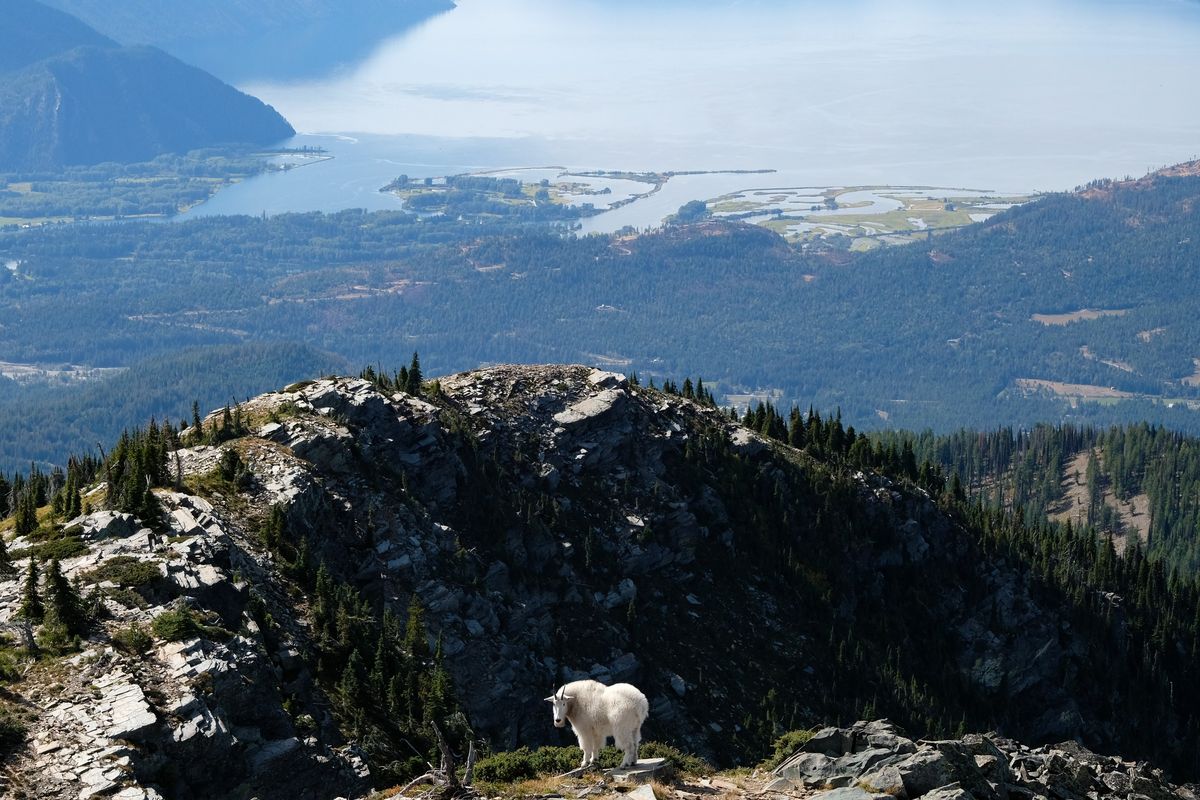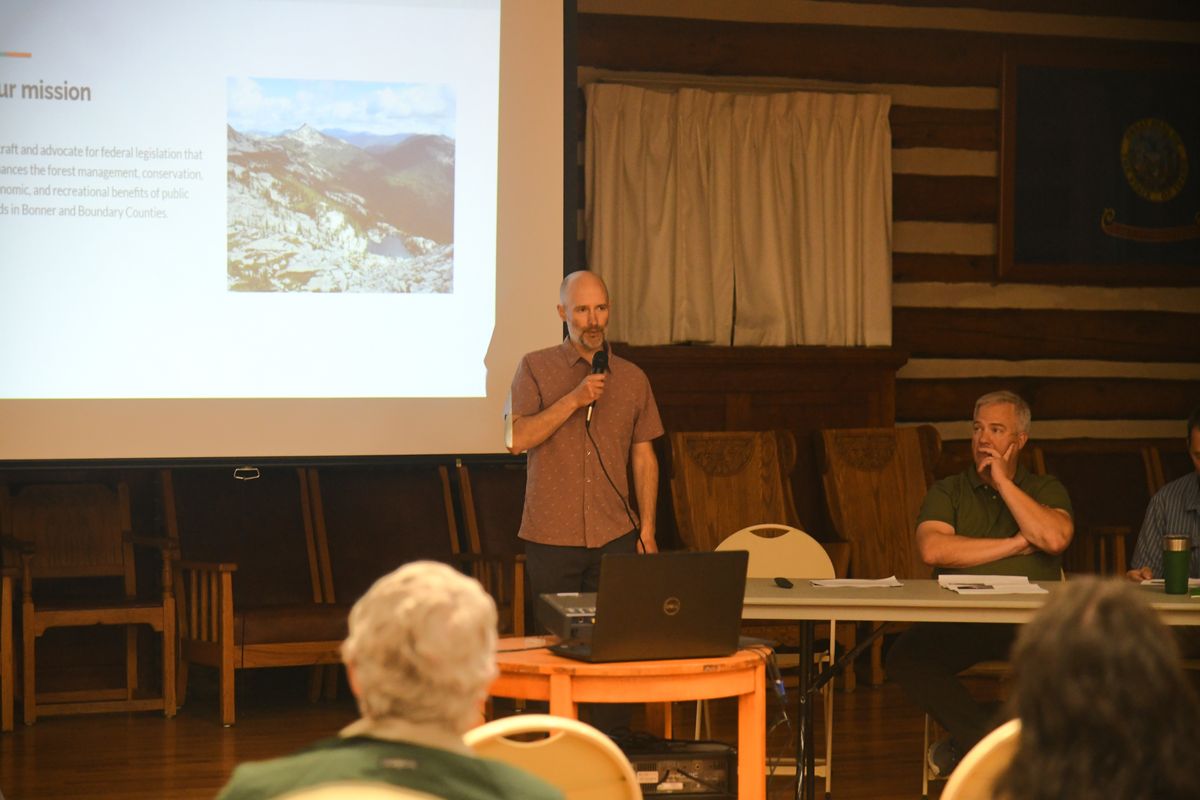A path forward: Collaborative forms to craft public lands legislation for North Idaho
A mountain goat eyes hikers Sept. 22 at the top of Scotchman Peak near Clark Fork, Idaho. (Tyler Tjomsland/The Spokesman-Review)
SANDPOINT – Idaho is home to some of the country’s most spectacular wilderness areas.
There’s the Selway-Bitterroot, designated in 1964 with the signing of the Wilderness Act. Just south of that one, there’s the Frank Church-River of No Return, designated in 1980, the largest contiguous wilderness area in the Lower 48 states.
There are 13 others around the state. They protect rocky peaks in the Sawtooths, swaths of desert in the southwest and the deepest river gorge in North America.
In all, it adds up to more than 4.7 million acres of protected wilderness in the state.
And yet not a single acre of that total is in the Idaho Panhandle.
A new effort to change that was unveiled to the public at an open house in Sandpoint this past week.
Called the Idaho Panhandle Public Lands Initiative, it’s a collaborative group made up of people representing conservation groups, the timber industry, snowmobile clubs and more.
The group’s goal is to agree on a suite of land management proposals for public lands in Boundary and Bonner counties that can become a bill to be introduced in Congress.
Brad Smith, the Sandpoint-based conservation director for the Idaho Conservation League, is the force behind the group. It’s not focused solely on wilderness – its mission includes improving forest management and other items – but getting wilderness designated in the Panhandle is a goal for him and some other members.
The only way to get that done, Smith said on Wednesday, is to have broad support, including from people like loggers or snowmobilers who have historically opposed wilderness.
“It’s going to require a collaborative process of the different interest groups that care about this land to come to an agreement in order to convince our congressional officials to act,” Smith said.
The initiative is still in its infancy, and has no formal proposals . Pam Duquette, a member of the group representing the Great Old Broads for Wilderness, said the initiative has a “lofty goal” of making a recommendation in 2025.
There are already critics. Paul Sieracki, of the Inland Empire Task Force, is worried that it will end up producing a watered-down wilderness proposal that gives up too much to loggers and motorized recreation groups. He worries that roadless areas would be released for development as part of an agreement.
During the meeting Wednesday, he read a short statement laying out his group’s reservations about a collaborative process.
“Achieving a middle ground like a collaborative approach will not benefit wildlife with all the compromises being made,” Sieracki said.
Wilderness campaigns for the Idaho Panhandle have fallen flat in the past. The original proposal for the Salmo-Priest Wilderness included thousands of acres in Idaho. The bill that created it only designated lands in Washington, and legislation designating the Idaho portion never crossed the finish line.
A bill to protect lands around the Scotchman Peaks was introduced in Congress in 2016. It didn’t advance, and U.S. Rep. Jim Risch declined to reintroduce the bill in 2018 after Bonner County voters rejected a ballot initiative proposing a 13,000-acre Scotchman Peaks wilderness area.
Administrative protections exist in the Idaho Panhandle National Forest’s 2015 forest plan. The plan includes a little more than 69,000 acres of recommended wilderness in Boundary and Bonner counties, including the Idaho portion of the Salmo-Priest, the Scotchman Peaks and a chunk of the Selkirk Crest.
Those protections mean those areas are managed as wilderness, but they aren’t permanent, which is why some want to see congressional action.
Making that action happen isn’t as simple as drawing a line on a map and finding a friendly politician.
“Getting wilderness done in Idaho requires compromise,” Smith said in an interview late last month. “And it requires working with local stakeholders in order to gain that support.”
He began shopping the idea for the initiative around after being part of a collaborative group that managed to find agreement on a proposal for winter travel plan – one that gave both conservationists and motorheads something to like, but that neither side would call perfect.
Though that plan is on hold , Smith saw it as a sign of what was possible, and he began wondering if the same sort of consensus could be reached on a bill that could go before Congress.
He reached out to a number of people throughout Boundary and Bonner counties, including his fellow conservationists and loggers, ranchers, local government officials and more.
People were willing to join, and some of them were the same characters Smith had worked with on other initiatives in the past.
Among them was Alan Harper, the resource manager for the timber company Idaho Forest Group.
Harper said he got involved not because the timber company wants to open any specific areas to logging, but because he thought it was the right thing to do.
He’s seen many attempts to push forward wilderness designations, and he’s interested in seeing permanent action, particularly on the areas that the Forest Service has recommended as wilderness.
“In my opinion, it’s time to put it to rest and make a decision,” Harper said.
Other members are opposed to wilderness designation, said Stan Myers, a hunter from Hope. Myers said the goal is to see if wilderness advocates and opponents can work out an agreement.
“We won’t know until we try, and this effort is trying to do that,” Myers said.
Some in the audience on Wednesday were skeptical of the group and how its membership was chosen, and that more hard-line environmentalist types like Sieracki were left out.
Smith listed dozens of people and groups he contacted, and said he tried to build a core group to get the ball rolling. He also said the group is designed to accept more members – while there are about a dozen, he expects that number to grow. The meetings, which will happen monthly and alternate between Sandpoint and Bonners Ferry, will be open to the public.
None of the members seems to have a set idea of what should happen as a result of the initiative. The forest plan gives them a starting point, but it’s not their proposal for a bill, nor does it constrain what they might consider.
Smith said they likely won’t vote on anything for many months, and there will be ample time to wrangle over the details.
“It’s going to be a very long and robust process,” Smith said.

